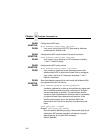
Chapter 15 Complete Command List
314
• off. no job control; no SOJ/EOJ commands. The printer prints
faster in off mode.
• standard. (the default) traditional job control with immediate
acknowledgements of SOJ/EOJ commands.
• enhanced. job control with EOJ acknowledgements held off by
the printer until job is fully printed. The printer prints slower in
enhanced mode.
To monitor the printer, use the telnet command “lpstat.” The normal
status reported on the first line of the lpstat response is the status of
the queue (LPQ) within the NIC. The status reported does not
reflect the state of the print job once it has been sent from the NIC
to the printer.
The new line at the bottom of the lpstate response labeled “printer
job:” can report one of two status values:
a. In Progress. A job in the printer is not yet finished.
b. Done. There are no jobs in the printer. All previous jobs are
finished.
Example:
store pserver opts jobsecurity jobtimeout 5
If jobsecurity is disabled, any user can cancel queued jobs
on the NIC including guest users. If jobtimeout is set to
some value other than 0, the NIC will only wait this amount of
seconds when getting printer feedback. This is only used if
you have a logpath port and type set on a particular destination.
store pserver tcpsocket <tcp-port> port <new-tcp-port>
Example:
store pserver tcpsocket 4000 port 5000
Change a pre-defined
TCP port number (<tcp-port>) on the
NIC to a new TCP port number (<new-tcp-port>). The default
number is 9100 for prn.
store pserver tcpsocket <tcp-port> dest <dest>
Example:
store pserver tcpsocket 5000 dest d1prn
Assign a pre-defined TCP port number (<tcp-port>) to a
particular destination (<dest>) on the NIC. Therefore, if you are
using a print method that sends jobs directly to a TCP port
number, you still have the option to process the job data
through this destination setting.


















